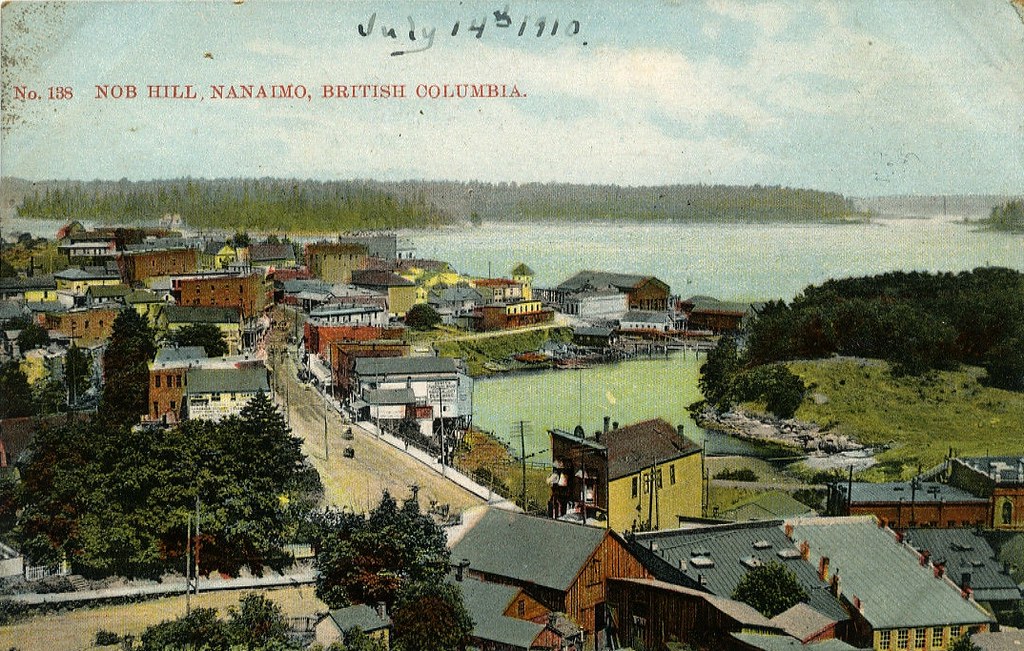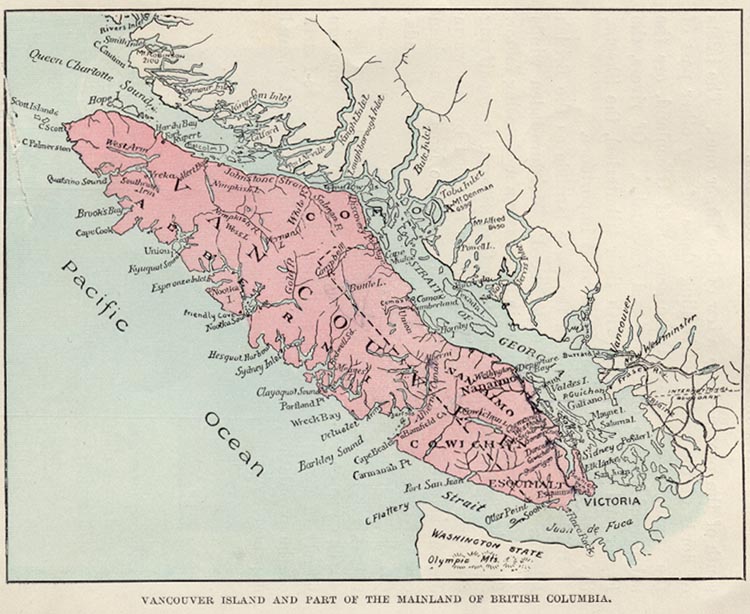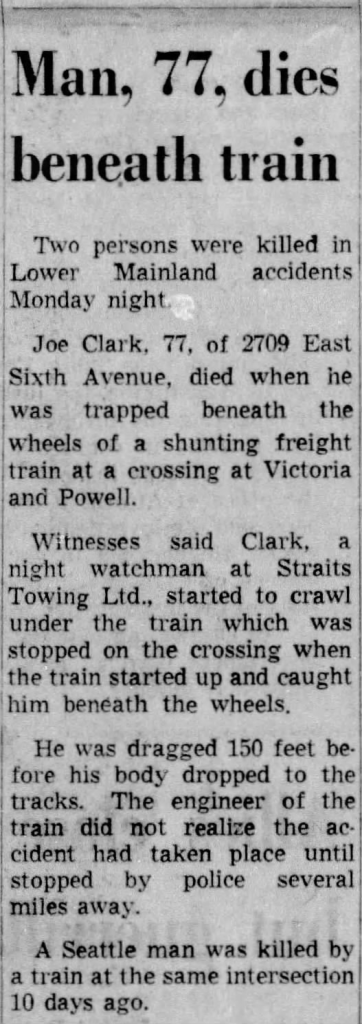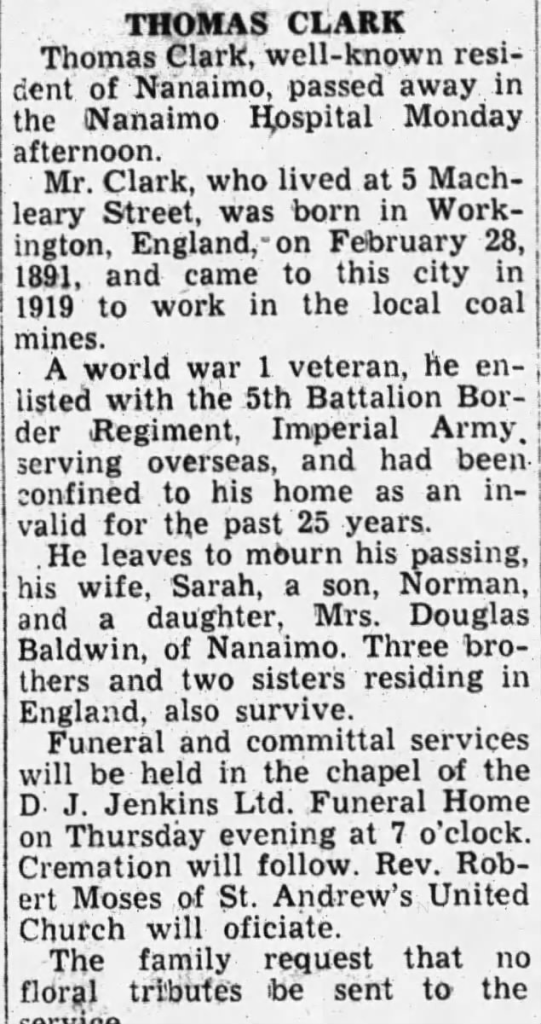Clarks of Cumberland in British Columbia

At the turn of the 20th century, the Clark family of Workington, Cumberland, had embraced theSecond Industrial Revolution and were gainfully employed in the mines and foundries of the northwest of England. Our 2nd Great Grandfather William CLARK followed the steelworks however all his brothers and nephews were coal miners, hewers, working directly at the coal face. Three of those miners left Workington for the coal fields of Nanaimo, British Columbia.
Nanaimo was established in 1852 by the Hudson Bay Company (HBC) to exploit the newly discovered coal seams. In order to recruit coal miners to the edge of the Empire, HBC offered free passage in exchange for five years indentured servitude, but the reality of the frontier life did not match the expectations set by the company. The miners chafed under HBC’s oppressive yolk, resulting in strikes and desertion. HBC abandoned mining altogether within a decade, selling its assets to private companies, which fared little better negotiating with their employees and keeping the mines open.
A large percentage of the island miners and diehard unionists were members or descendants of the “charter” ethnic group in the coalfields: Scots and northern English who had sailed around the Horn as collier-emigrants to British Columbia before 1900. Many more British miners followed in their wake to the Canadian west, leaving a lasting imprint on the coal community and its industrial relations. Their intense communal loyalties, knowledge of trade unionism and conceptions of British “liberties” formed an essential part of the matrix of coalfield labour. Most labour leaders in the western coalfields were British-born, although the influence of migrants from the eastern coalfields is not to be understated.
Socialists and Workers, The Western Canadian Coal Miners, 1900-21, Allen Seager, Volume 16, 1985
Into the 20th Century, Nanaimo was relatively unique for having huge numbers of industrial workers clustered in a single industry in a single location. Thus Nanaimo became a hotbed for union activity, labour activism and left-wing politics, a reputation it has maintained to this day.
20th century migrants departed from Liverpool or Glasgow aboard the transatlantic steamships which disembarked passengers in St Johns, Halifax, or Montreal. From the east coast, the transcontinental railways would deliver the miners and their families across Canada to Vancouver. Local railways and ferries led the travelers to their final destination in Nanaimo, Vancouver Island.


Vancouver Island, c. 1913
This map was a plate in a school textbook, A History and Geography of British Columbia (1913). The dotted line down the middle of the Island indicates the massive tract of land given to the Esquimalt & Nanaimo Railway (1883).
James Clark & Frances Annie Amy Hobby
The first of our family to brave the migration was James Clark (1882-1967). James left his two children and pregnant wife in Workington when he departed for Nanaimo, British Columbia, in 1907.
James’ obituary states he was a Boer War veteran but according to his military records, as a teenager, he served less than a year in the Royal Garrison Artillery in England. On the verge of being shipped overseas he bought out his remaining 6 year commitment for £10. Returning to Workington, James worked 5 years as a hewer in the coal mines, then emigrated to Nanaimo, age 25. He worked for 4 years in the Nanaimo coal mines before sending for his wife and three children. Three more sons were born in British Columbia.
In the summer of 1915, age 33, James enlisted with the 11th Canadian Mounted Rifles, Canadian Overseas Expeditionary Force but was discharged before the end of the year as medical unfit. In April the following year, James enlisted again, this time as a Sapper with 2nd Tunnelling Company, and completed basic training. James returned to Europe on the troop ship, SS Scotian, trained in England, prior to serving six months on the frontline in France. He was able to leverage his years of mining experience to dig trenches and tunnels to undermine enemy fortifications.
Promoted to Sergeant, James’ war came to an untimely end when he fell down a sap (covered trench) and dislocated his jaw. Not for the first time. His first dislocation had occurred while boxing in 1913. James remained in England until the end of the war, far away from the front lines.
Returning to Nanaimo, James picked up where he left off, returning to the family and employment in the coal mine. They continued to rent their miner’s cottage and their youngest son, Harry, was born in 1920. The family appears to have thrived in B.C. as they left six children, eleven grandchildren, and eight great-grandchildren when they passed away in their 80s.
Obituary: Mrs F A A Clark – Nanaimo Daily News

Obituaries
Lived Nanaimo for 55 YearsMRS F. A. A. CLARK
Mrs. Frances Annie Amy Clark, a resident of 587 Rosehill Ave, Nanaimo, at Nanaimo Regional General Hospital, Thursday. She was born at Southampton, England and was 84 years of age.
Mrs. Clark came to Canada to Nanaimo in 1911 and had resided here since that time.
Mrs. Clark is survived by ber husband, James, at home; four sons, Joseph, James and Harry, Nanaimo; and John, Victoria; two daughters, Mrs. W. (Mary) Milligan, Cedar; and Mrs. T. (Doris) Denny, Victoria; 11 grandchildren and eight greatgrandchildren. Funeral services will be held in Westwood Chapel of Flowers, Saturday, at 2:30 p.m. Rev. W. C. Irvine of Evangelistic Tabernacle will officiate.
Interment will be in Cedar Valley Memorial Garden.
Nanaimo Daily News, Nanaimo, British Columbia, Canada • Fri, Jul 15, 1966, Page 12
Obituary: James Clark – Nanaimo Daily News
Obituaries
Was Veteran of Boer WarJAMES CLARK
James Clark of 587 Rosehill Ave., died at Nanaimo Regional General Hospital, Tuesday, June 27. He was born at Workington, Cumberland, England and was 85 years of age. Mr. Clark came to Canada to Fernie, B.C. in 1907 and moved to Nanaimo shortly after and worked in the local coal mines.
He was a veteran of the Boer War and of the First World War.
In his younger days he was a very good amateur boxer and was also known to be a very good concert singer.
His wife, Frances Annie Amy, died in July, 1966. He is survived by four sons, Joseph, Harry and James, Nanaimo, and John, Victoria; two daughters, Mrs. W. (Mary) Milligan. Cedar, and Mrs. J. (Doris) Denny, Victoria.
Funeral services will be held in Westwood Chapel of Flowers, Friday, June 30, at 2:30 p.m. Rev. Vance of Pentecostal Tabernacle will officiate.
Interment will be in Cedar Valley Memorial Garden.
Nanaimo Daily News, Nanaimo, British Columbia, Canada • Thu, Jun 29, 1967, Page 9

Joseph Clark & Mary E Crossley
James’ brother Joseph Clark (1888-1966), visited Vancouver with his father for nine months in 1911. As a coal miner with five years experience he returned in 1912, again with their father, John Clark (1850-1913), a coal miner turned grocer. Sadly their 63 year old father survived less than a year, dying in East Wellington, a suburb of Nanaimo City.
As war broke out in Europe the call went out in the colonies for citizens of the Empire to volunteer for the Imperial Army. The brothers James and Joseph Clark, aged 33 years and 29 years respectively enlisted together in Vernon, BC.
Joseph joined the 62nd Battalion, Canadian Overseas Expeditionary Force, listing his sister as Mrs (Jane) David Holiday in Workington as his nearest relative. After seven months in Canada, Private Joseph Clark departed Halifax, Nova Scotia, 30 March 1916 aboard the SS Baltic bound for England. Joseph did not reach the front line in France until August, serving as replacements/reinforcements for the 8th Battalion. The battalion saw action in many of the Canadian Corps’ most famous and infamous battles including The Somme, Paschedaele, Amiens, Arras, & Cambrai.
In the closing months of the war Joseph received two promotions, first to Lance Corporal then Corporal, before being was granted leave to return to England to marry his fiancé, Mary Ethel Crossley. They married in Whitehaven in May 1919.
Joseph returned home via troop ship to be demobilized in May 1919 while his new wife travelled separately in 1920. Joseph returned to the coal mine and the couple rented a miners cottage in The Mountain District (New Castle) of Nanaimo. However by 1930 Joseph had switched careers to that of a window cleaner and they relocated to East Vancouver.
After retirement Joseph continued working as a night watchman for a large towboat company. It was on a fateful night walking to work that Joe died attempting to climb through a train blocking a crossing on his road to work. Mary remained in their home on East Sixth Street until her passing aged 94 in 1976.
Joseph Clark: Man, 77, dies beneath train – The Province

Man, 77, dies beneath train
Two persons were killed in Lower Mainland accidents Monday night.
Joe Clark, 77, of 2709 East Sixth Avenue, died when he was trapped beneath the wheels of a shunting freight train at a crossing at Victoria and Powell.
Witnesses said Clark, a night watchman at Straits Towing Ltd started to crawl under the train which was stopped on the crossing when the train started up and caught him beneath the wheels.
He was dragged 150 feet before his body dropped to the tracks. The engineer of the train did not realize the accident had taken place until stopped by police several miles away.
A Seattle man was killed bty
The Province
Vancouver, British Columbia, Canada •
Tue, Feb 8, 1966
Page 2
Death Notice, Mary Ethel Clark – Vancouver Sun
CLARK — In hospital on June 14, 1976, Mary Ethel Clark, aged 94 years, formerly of 2709 E 6 Ave., Vancouver. Predeceased by her husband Joseph. Funeral service, Thursday, June 17 at 1:30pm in the Chapel of RICHMOND FUNERAL HOME, 842 Cambie Road, Richmond. Rev G. Dale officiating. Cremation.
The Vancouver Sun
Vancouver, British Columbia, Canada • Wed, Jun 16, 1976, Page 72

Thomas Clark & Sarah Tubman
James & Joseph’s first cousin, Thomas Clark (1891-1954), also a coal miner hewer, was living and working in Workington when he married Sarah Tubman in April 1913.
At the outbreak of war Thomas enlisted with the 5th Battalion Border Regiment but was discharged within six months as medically unfit due to rheumatism, having never left England. Thomas was awarded the Silver War Badge. The sterling silver lapel badge was intended to be worn in civilian clothes. It had been the practice of some women to present white feathers to apparently able-bodied young men who were not wearing the King’s uniform.
Post war in 1919, Thomas emigrated to Nanaimo, British Columbia, leaving his wife in Workington with their infant children, Elizabeth Alice 3 and Norman 1. Working as coal miner, Thomas only waited six months to bring his family over to join him in October.
Tragically Thomas was injured in 1929 and spent the last 25 years of his life as an invalid, unable to work.
In 1939 news from Workington of Thomas’ younger brother being killed in a mining accident was reported in the Nanaimo Times. Working solo at the coal face, John was crushed under a rock fall.

Athlete, Well Known In Cumberland And Nanaimo, Loses Son
Of interest to local residents is the news received by relatives in this city of the accidental death of John William Clark, aged 32 years. A native of Workington, England. he was killed in a mining accident at Lorca, October 20th.
He was the youngest son of George Clark, a former well known Old Country rugby and football player who is well known to Cumberland residents here.
A brother Thomas Clark resides in Nanaimo.
Nanaimo Daily News, Nanaimo, British Columbia, Canada • Tue, Nov 14, 1939, Page 2
Obituary: Thomas Clark – Nanaimo Daily News
THOMAS CLARK
Thomas Clark, well-known resident of Nanaimo, passed away in the Nanaimo Hospital Monday afternoon.
Mr. Clark, who lived at 5 Machleary Street, was born in Workington, February 28, 1891, and came to this city in 1919 to work in the local coal mines.
A world war 1 veteran, he enlisted with the 5th Battalion Border Regiment, Imperial Army, serving overseas, and had been confined to his home as an invalid for the past 25 years.
He leaves to mourn his passing, his wife, Sarah, a son, Norman, and a daughter, Mrs. Douglas Baldwin, of Nanaimo. Three brothers and two sisters residing in England, also survive.
Funeral and committal services will be held in the chapel of the D. J. Jenkins Ltd. Funeral Home on Thursday evening at 7 o’clock. Cremation will follow. Rev. Robert Moses of St. Andrew’s United Church will oficiate.
The family request that no floral tributes to be sent to the service.
Nanaimo Daily News, Nanaimo, British Columbia, Canada •Tue, Jun 15, 1954, Page 2

Obituary: Mrs Sarah Clark – Nanaimo Daily News

Nanaimo Resident Born in England
MRS. SARAH CLARKMrs. Sarah Clark, well known and highly respected resident of 5 Machleary street, passed away in the Nanaimo Hospital. Saturday morning. April 21, following a lengthy illness.
Mrs. Clark was born at Harrington. England, and came to Nanaimo 35 years ago. She was 63 years old at the time of her death.
Predeceased by her husband Thomas in June 1954, Mrs. Clark is survived by a son, Norman, a daughter, Mrs. Doug (Alice) 1 Balburn and a grandchild. Sisters and brothers in England also survive.
Funeral services will be held on Monday evening at 7.30 from the Chapel of D. J. Jenkins Ltd. Funeral Home, with Rev Robert Moses of St. Andrew’s church officiating. Cremation is to follow. Kindly omit flowers.
Nanaimo Daily News, Nanaimo, British Columbia, Canada • Sat, Apr 21, 1956, Page 5
Family Tree
Our Nanaimo relatives all descended from our 3rd Great Grandparents Joseph CLARK (~1820-?) & Jane DREWERY (1828-1881) who lived and worked in Workington, Cumberland, in the north west of England.
- Joseph CLARK (1820-?) & Jane DREWERY (1828-1881)
- John Clark (1850-1913) & Mary Ann Ledger (1844-1892)
- Jane Clark (1873-?)
- Annie Raven Clark (1875-1957)
- Jessie Clark (1880-1901)
- James Clark (1882-1967) & Frances Annie Amy Hobby (1882-1966)
- Hilda Doris Clark (1904-1985)
- John “Jack” Clark (1906-1993)
- Mary Annie Clark (1908-1990)
- Joseph Clark (1914-?)
- James Edward Clark (1916-1993)
- Harry Clark (1920-1995)
- Joseph Clark (1888-1966) & Mary Ethel Crossley (1882-1976)
- William CLARK (1852-1902) & Ann BOWNESS (1855-1928)
- George CLARK (1890-1983) & Annie WANDLESS (1897-1969)
- Albert Wear CLARK(1921-1983) & Sheila Mary HUDSON (1925-2016)
- Our direct line…
- Albert Wear CLARK(1921-1983) & Sheila Mary HUDSON (1925-2016)
- George CLARK (1890-1983) & Annie WANDLESS (1897-1969)
- Martha Clark (1853-1933)
- Joseph Clark (1856-1918)
- Mary Jane Clark (1858-1934)
- Daniel Clark (1860-1931)
- George Clark (1863-1940)
- Daniel Clark (1886-1870)
- Walter Clark (1888-1960)
- Thomas Clark (1891-1954) & Sarah Tubman (1892-1956)
- Elizabeth Ann Clark (1915-1986)
- Norman Clark (1918-1989)
- Mary J Clark (1893-?)
- Alice Clark (1895-1929)
- Joseph Henry Clark (1897-1980)
- Martha Clark (1900-?)
- John William Clark (1902-1939)
- Walter Clark (1866-?)
- Elizabeth Ann Clark (1869-1896)
- John Clark (1850-1913) & Mary Ann Ledger (1844-1892)
References
- Nanaimo’s Historical Development, City of Nanaimo
- Socialists and Workers, The Western Canadian Coal Miners, 1900-21, Allen Seager, Volume 16, 1985
- Canadian Pacific Railway, Wikipedia
- Life in Early Nanaimo, How We Got Here, By Andrew Farris, OnThisSpot
- Nanaimo Slide Collection, Royal Roads University
- Time Travels: Nanaimo Museum, BC Historical Federation
- ViHistory Maps, University of Victoria
- 2nd Canadian Tunnelling Company, Wikipedia
- 62nd Battalion (British Columbia), Canadian Expeditionary Force, Wikipedia
- 8th Battalion, Canadian Expeditionary Force, Wikipedia
- 5th Battalion (Reserve Cumberland) Border Regiment, Wikipedia
- Venus in the Trenches: The Treatment of Venereal Disease in the Canadian Expeditionary Force, 1914-1919, Lyndsay Rosenthal, Wilfrid Laurier University
- War Syndromes: The Impact of Culture on Medically Unexplained Symptoms, Edgar Jones & Simon Wessely, National Library of Medicine
- Map of Nanaimo Coal Mines, Coal Tyee History ProjectVIUSpace collection
- List of coal mines and landmarks in the Nanaimo area, Wikipedia
- Coal Mining Nanaimo, Heritage Tours
- John William Clark, Lowca 10, Whitehaven, In Memoriam, Durham Mining Museum
- Workington Man Killed At Lowca Colliery, 17 October 1939, Durham Mining Museum
- John William Clark (1902-1939), Harrington No. 10 Colliery, Cumbria at War, 1939–45, GoogleBooks






1 Response